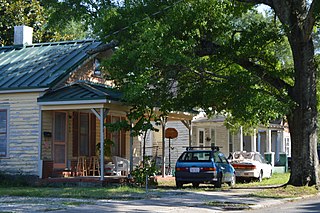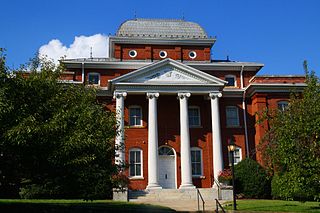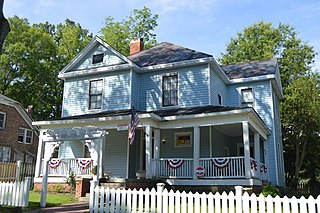
Saint Mary's School is a private independent Episcopal college-preparatory, boarding and day school for girls in grades 9–12. Located in Raleigh, North Carolina, Saint Mary's School operates as an independent school with a historic association with the Episcopal Church including an Episcopal chapel, St. Mary's Chapel, on the school's grounds. The school formerly operated as Saint Mary's College and for many decades educated young women in grades 11–12 and their freshman and sophomore years in college. The school changed to a four year high school in 1998, at which point the name reverted to Saint Mary's School, the original name of the institution when it was founded in 1842.

Hillsborough Historic District is a national historic district located at Hillsborough, Orange County, North Carolina. The district encompasses 529 contributing buildings, 9 contributing sites, 13 contributing structures, and 2 contributing objects in the central business district and surrounding residential sections of Hillsborough. The district includes buildings dating to the late-18th and early-20th century and includes notable examples of Federal, Greek Revival, and Italianate style architecture. Located in the district are the separately listed Burwell School, Eagle Lodge, Hazel-Nash House, Heartsease, Montrose, Nash Law Office, Nash-Hooper House, Old Orange County Courthouse, Ruffin-Roulhac House, Sans Souci, and St. Matthew's Episcopal Church and Churchyard. Other notable buildings include Seven Hearths, the Presbyterian Church (1815-1816), Methodist Church (1859-1860), First Baptist Church (1862-1870), Twin Chimneys, and the Berry Brick House.

East Home Avenue Historic District is a national historic district located at Hartsville, Darlington County, South Carolina. The district encompasses 52 contributing buildings and 1 contributing site in a primarily residential section of Hartsville. They were constructed between about 1890 to about 1938, and is associated with the leading figures of the town's history. Home Avenue has historically been the major residential street in Hartsville since it was laid out and landscaped in 1890. Architectural styles and influences include Renaissance Revival, Colonial Revival, Classical Revival, American Craftsman, and Bungalow. Notable non-residential buildings include the First Baptist Church, Thornwell Elementary School, and Hartsville Public School. Located in the district is the separately listed John L. Hart House.

East Durham Historic District is a national historic district located at Durham, Durham County, North Carolina. The district encompasses 731 contributing buildings and 1 contributing site in a predominantly residential section of Durham. The buildings primarily date between about 1890 and 1955 and include notable examples of Classical Revival and Queen Anne architecture. Notable buildings include the Holloway Street School (1928), East Durham Junior High School, Advent Christian Church (1920s), John Cheek House (1899), Community Groceries (1900), George Brown Grocery Store (1920), Seagroves Grocery Store (1915), and The People's Bank (1921).

Trinity Historic District, also called Trinity Park, is a national historic district and residential area located near the East Campus of Duke University in Durham, North Carolina. The district encompasses 751 contributing buildings in a predominantly residential section of Durham. They were built between the 1890s and 1960 and include notable examples of Queen Anne and Bungalow / American Craftsman style architecture. Located in the district are the separately listed "Faculty Row" cottage: the Bassett House, Cranford-Wannamaker House, Crowell House, and Pegram House. Other notable buildings include the George W. Watts School (1917), Julian S. Carr Junior High School (1922), Durham High School (1923), Durham Alliance Church (1927), Trinity Presbyterian Church (1925), Great A & P Tea Company (1927-1929), Grace Lutheran Church, and the former Greek Orthodox Community Church.

Belmont Historic District is a national historic district located at Belmont, Gaston County, North Carolina. It encompasses 264 contributing buildings, 1 contributing site, and 2 contributing structures in the central business district and adjacent residential areas of Belmont. The district was developed after 1873, and includes notable examples of Colonial Revival, Tudor Revival, and Bungalow / American Craftsman architecture. Located in the district is the separately listed U.S. Post Office, Former. Other notable buildings include the R.L. Stowe Mills Office Building, Bank of Belmont (1926), Piedmont and Northern Railroad Depot, Belmont Hotel, Abel C. Lineberger House No. 2 designed by Charles Christian Hook (1870–1938), Samuel Pinckney Stowe House, James W. Stowe House, Sacred Heart College, and Belmont High School (1939).

Summit Avenue Historic District, also known as the Dunleath Historic District and formally as the Charles B. Aycock Historic District, is a national historic district located at Greensboro, Guilford County, North Carolina. The district encompasses 226 contributing buildings in a middle- and upper-class residential section of Greensboro. The houses were largely built between the 1890s and 1930s and include notable examples of Queen Anne, Colonial Revival, American Foursquare, and Bungalow / American Craftsman-style architecture. The Sigmund Sternberger House (1926) is listed separately. Other notable buildings include the John C. Clapp House, Robert L. Potts House, William B. Vaught House, Edgar B. Jennette House, and the Charles B. Aycock School (1922) designed by Starrett & van Vleck.

Benson Historic District is a national historic district located at Benson, Johnston County, North Carolina. It encompasses 104 contributing buildings in the town of Benson. It includes notable examples of Late Victorian and Bungalow / American Craftsman style architecture and buildings dating from about 1900 to 1930. It includes commercial, residential, ecclesiastical, and educational structures. Notable buildings include the Farmers Commercial Bank (1921), C. T. Johnson Building (1910), James E. Wilson Livery Stable· and Store, Carolina-Parrish Hotel, Boon-Lawhorn House, Lonnie Stevens House, Dr. Parker-Allen House, Baptist Church (1914-1915), United Methodist Church (1917), and Benson Elementary School.

West Selma Historic District is a national historic district located at Selma, Johnston County, North Carolina. It encompasses 217 contributing buildings, 1 contributing site, and 1 contributing structures in predominantly residential section of Selma. It includes notable examples of Queen Anne, Gothic Revival, Moderne, and Bungalow / American Craftsman style architecture and buildings dating from about 1880 to 1961. Located in the district is the separately listed Nowell-Mayerburg-Oliver House and William E. Smith House. Other notable buildings include the Edgerton Memorial Methodist Episcopal Church, Abdalla House, Dr. Joshua W. Vick House, Stella and William H. Etheridge House, Dr. R. Marvin Blackmon House, Samuel P. Wood House (1935), Janie and C. E. Kornegay House (1923), Selma Presbyterian Church, St. Gabriel's Episcopal Church/Vernon Wiggs House, and Pepsi Bottling Company.

Mill Avenue Historic District is a national historic district located at Jacksonville, Onslow County, North Carolina. The district encompasses 31 contributing buildings, 1 contributing site, and 1 contributing structure in a predominantly residential section of Jacksonville. The district developed after 1890 and includes notable examples of Late Victorian and Bungalow / American Craftsman style architecture. Notable contributing buildings include the Jarman Hotel, Jacksonville Depot, Richard Ward House, Richard Ward Guest House, the Lockamy-Chadwick House, George Bender House (1901), Samuel Ambrose House, the Marine House, Steve Aman House, and the Henrietta Jarman House.

Swansboro Historic District is a national historic district located at Swansboro, Onslow County, North Carolina. The district encompasses 74 contributing buildings and 1 contributing site in the central business district and surrounding residential sections of Swansboro. The district largely developed between 1890 and 1925 and includes notable examples of Federal, Greek Revival, and Bungalow / American Craftsman style architecture. Notable contributing buildings include the Jonathan Green House, Beaufort House, Bazel Hawkins House, George E. Bell House, James Elijah Parkin House (1893), William Pugh Ferrand Store, the Robert Spence McLean Store, Watson and Parkin "double store" (1910), Jim Kennedy Fish House (1930s), Baptist Church (1897), and the Emmerton School (1920s).

Renston Rural Historic District is a national historic district located near Winterville, Pitt County, North Carolina. The district encompasses 105 contributing buildings, 6 contributing sites, 7 contributing structures, and 1 contributing object on eight major farms in rural Pitt County near Winterville. It includes buildings largely dated from about 1890 to 1953 and notable examples of Greek Revival and Classical Revival style architecture. They include the Fletcher Farm, the Charles and Maggie McLawhorn farms, the Langston-Edwards properties, the Dail Farm, the Dennis McLawhorn farms, the McLawhorn-Abbott property, and the Richard Herman McLawhorn farms. Notable individual buildings include the Joseph Smith House, former Renston School and the first Bethany Free Will Baptist Church, Spier Worthington House, Langston-Edwards House, the Dail House, and the Charles McLawhorn House.

North Long Street–Park Avenue Historic District is a national historic district located at Salisbury, Rowan County, North Carolina. The district encompasses 46 contributing buildings in a predominantly residential section of Salisbury. It was developed largely between about 1890 and 1925, and includes notable examples of Gothic Revival, Colonial Revival, and Bungalow / American Craftsman style. It was listed on the National Register of Historic Places in 1985.

Danbury Historic District is a national historic district located at Danbury, Stokes County, North Carolina. The district encompasses 44 contributing buildings in the central business district and surrounding residential section of Danbury. They were built between about 1860 and 1930 and include notable examples of Queen Anne, Romanesque Revival, and Bungalow architecture. Located in the district and separately listed is the Stokes County Courthouse. Other notable buildings include the County Jail (1904), Petree Store, the Martin Store, Stack-Bickett Law office (1888), Bank of Stokes County, McCannless Hotel, James Pepper House, Wilson Fulton brick house, Samuel H. Taylor House/Hotel, the N. E. Wall House, Baptist Mission Church, Clark Memorial Presbyterian Church, and the Methodist Church.

Cary Historic District is a national historic district located at Cary, Wake County, North Carolina. The district encompasses 39 contributing buildings in a predominantly residential section of Cary. The district developed between about 1890 and 1945, and includes notable examples of Queen Anne and Bungalow / American Craftsman style architecture. Notable buildings include the former Cary High School built in 1939 by the Works Progress Administration, Esther Ivey House, Captain Harrison P. Guess House, and Dr. John P. Hunter House.

Plymouth Historic District is a national historic district located at Creswell, Washington County, North Carolina. The district encompasses 78 contributing buildings and 3 contributing structures in the central business district and surrounding residential sections of Creswell. It was largely developed between about 1874 and 1952 and includes notable examples of Colonial Revival, American Craftsman and Late Victorian style architecture. Notable buildings include the A. G. Walker Store, A. G. Walker House (1878), Hopkins Hotel (1890), Claude T. Spruill House (1890), Alfred Alexander House (1890), Bateman Store, 0. D. Hatfield Store, Christ Episcopal Church (1898), Creswell Baptist Church, Creswell Episcopal Methodist Church (1918), and Davenport's Market.

Lucama Municipal Historic District is a national historic district located at Lucama, Wilson County, North Carolina. It encompasses 42 contributing buildings in the railroad town of Lucama. The district developed between about 1890 to 1930 and includes notable examples of Classical Revival, Bungalow / American Craftsman, and Victorian style architecture. Notable buildings include the Will Davis Store, Jesse Lucas Store, Lucama Depot (1905), Kinchen Barnes Store, W. J. Newsome Store, Lousetta Newsome House (1887), Dr. Ben Hackney House, and Lucama Methodist Church (1915).

Broad–Kenan Streets Historic District is a national historic district located at Wilson, Wilson County, North Carolina. It encompasses 293 contributing buildings in a predominantly residential section of Wilson. The district developed between about 1890 to 1940 and includes notable examples of Colonial Revival, Bungalow / American Craftsman, and Queen Anne style architecture. Notable buildings include the Woman's Club of Wilson (1922).

West Nash Street Historic District is a national historic district located at Wilson, Wilson County, North Carolina. It encompasses 79 contributing buildings in a predominantly residential section of Wilson. The district largely developed during the 1910s and 1920s and includes notable examples of Colonial Revival and Bungalow / American Craftsman style architecture. Notable buildings include the William W. Graves House, Selby Hurt· Anderson House, Williams-Cozart House, John T. Barnes House, Graham-Woodard House, M. Douglas Aycock House (1925-1928), John D. Gold House, Boykin's Filling Station, and West End Grocery.

Bald Creek Historic District is a national historic district within the community of Bald Creek located about ten miles west of Burnsville, Yancey County, North Carolina.

















